Germany 2011 "150 years of discovery prehistoric bird Archaeopteryx"
| <prev | back to index | next> |
| Issue Date | 11.08.2011 |
| ID | Michel: 2887; Scott: 2635; Stanley Gibbons: 3733; Yvert et Tellier: 2712; Category: pF |
| Design | Julia Warbanow, Berlin |
| Stamps in set | 1 |
| Value | Euro 0.55 Archaeopteryx |
| Emission/Type | commemorative |
| Issue place | Berlin, Bonn |
| Size (width x height) | 35mm x 35mm |
| Products | FDC x1, FDS x1 |
| Layout | MS of 10 stamps (2x5) |
| Paper | stroke, white, fluoresce, special post paper DP 2 |
| Perforation | 13x13 |
| Print Technique | Multicolor offset print |
| Printed by | Bagel Security-Print GmbH & Co.KG, Moenchengladbach |
| Quantity | 6.510.000 |
| Issuing Authority | Deutsche Post |
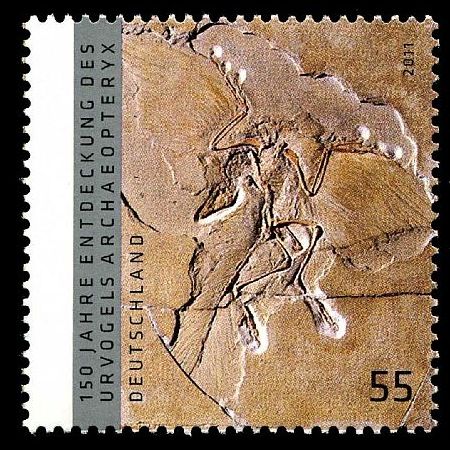
On August 18th, 2011, the German Post Authority issued the stamp "150 years of discovery prehistoric bird Archaeopteryx", printed in the Mini-Sheets of 10 stamps.
The prehistoric bird Archaeopteryx is one of the most famous fossils in the World. It was described in 1861 based on one feather cast. Later, when more complete specimens had been found, this fossil became important evidence for the Theory of Evolution. As an intermediate species from dinosaurs to birds, Archaeopteryx has both bird-like and reptile-like character traits in its skeleton.
The more bird-like features include feathers and limbs set up to act like springs (to get it into the air).
The more reptile-like features include teeth, claws on the fingers (and the fingers are more reptile-like), a long tail made up of caudal vertebrae.
The ancestor of Archaeopteryx was a small predatory dinosaur. All fossils of Archaeopteryx found so far come from the Solnhofen Plattenkalken at the Fraenkischen Jura regions of the state of Bavaria, Germany. They are approximately 150 million years old. The most exemplary fossil is stored at the Museum fuer Naturkunde in Berlin.
The design of both stamp and coin chosen was actually the winner of a competition. Other stamp candidates include:
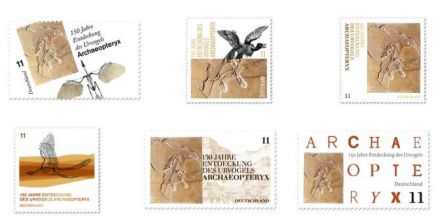 |
The second prize submission depicts the 1861 feather, but none of the submissions depicted the 1861 skeleton. The Berlin specimen, although not discovered until 1876, was the winning submission. This Archaeopteryx specimen appears in many pictures and illustrations of paleontology-related books, which is also depicted on the stamp.
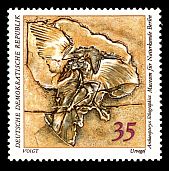 |
| Archaeopteryx on stamp of GDR from 1973, MiNr.: 1826, Scott: 1148. |
This fossil was already depicted on a stamp of GDR in 1973 as part of stamp set of 6 values, showing various fossils from the museum collection.
The initial discovery, a single feather, was unearthed in 1860 or 1861 and described in 1861 by Christian Erich Hermann von Meyer. It is currently also located at the Museum fuer Naturkunde in Berlin.
This is generally assigned to Archaeopteryx and was the initial holotype, but whether it actually is a feather of this species or another, as yet undiscovered, proto-bird is unknown. There are some indications it is indeed not from the same animal as most of the skeletons.
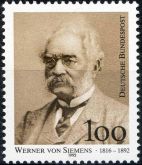
|
| Werner von Siemens on German stamp from 1992, MiNr.: 1768, Scott: 1768. |
The Berlin Specimen was discovered in 1874 or 1875 on the Blumenberg near Eichstaett, Germany, by farmer Jakob Niemeyer. He sold this precious fossil for the money to buy a cow in 1876, to inn-keeper Johann Doerr, who again sold it to Ernst Otto Haeberlein, the son of K. Haeberlein. Placed on sale between 1877 and 1881, with potential buyers including O.C. Marsh of Yale University's Peabody Museum, it was eventually bought by the Natural History Museum of Berlin for 20,000 Goldmark.
The transaction was financed by Ernst Werner von Siemens (depicted on several German stamps), founder of the famous company that bears his name. Described in 1884 by Wilhelm Dames, it is the most complete specimen, and the first with a complete head. It was in 1897 named by Dames as a new species, Archaeopteryx siemensii; a recent evaluation supports the Archaeopteryx siemensii species identification.
Some paleontologists say that Archaeopteryx is not the first bird, but the last flying dinosaur.
Products and associated philatelic items
| FDC official and personalized | Mini-Sheet | |
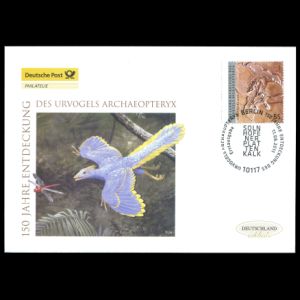 |
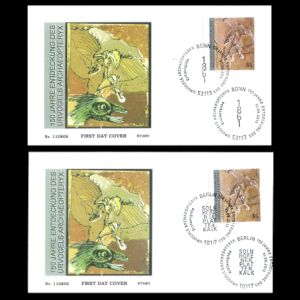 |
 |
| First-Day-of-Issue Postmarks | Additional commemorative Postmark | |||
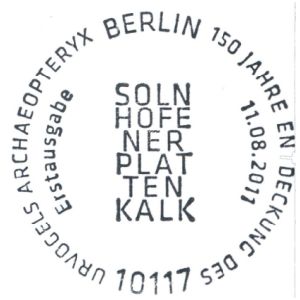 |
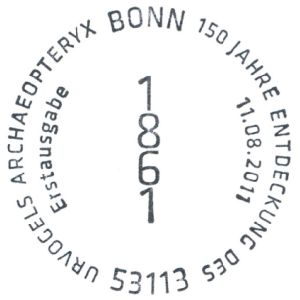 |
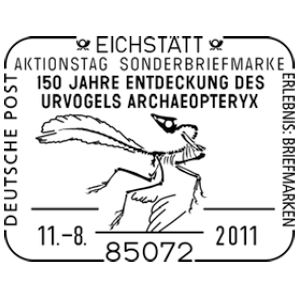 |
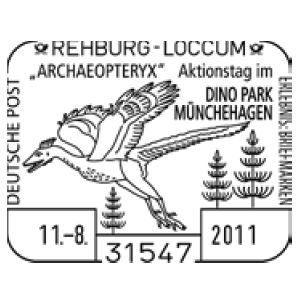 |
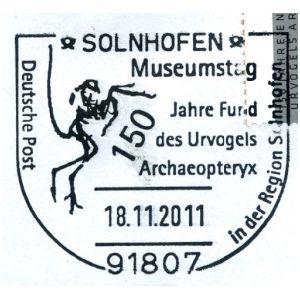 |
There are two postmarks issued with this stamp:
Three additional postmarks issued by Deutsche for some other location that have some connection to Archaeopteryx:
|
||||
| Souvenirs and commemorative materials | ||
| First Day Sheet | Souvenir Booklet with images of some drafts | Souvenir Booklet of Deutsche Post |
 |
 |
 |
| Presentation card of German Federal Ministry of Finance | Numismatic Sheet | |
 |
 |
|
| Examples of circulated covers | ||
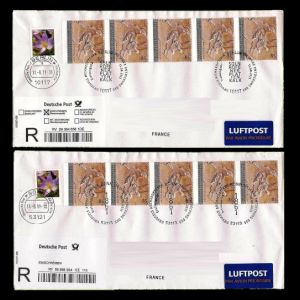 |
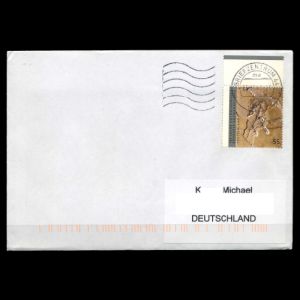 |
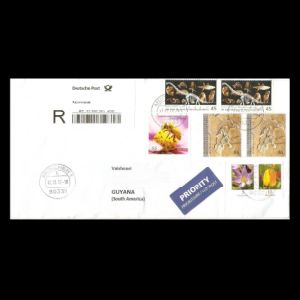 |
|
The letters were sent on the stamps issue day and were cancelled by Berlin and Bonn
First-Day-of-Issue Postmarks. |
The letter was dropped in the postbox near the Bürgermeister-Müller-Museum in Solnhofen. Due to the fact, the village is too small and the post office is not available there, the letter was cancelled at the regional mail sorting center. |
The registered letter posted from Munich to Guyana on 12.12.12, with the Archaeopteryx
and the "Bicentenary of Nature Science Museum in Berlin"
stamps of Germany. |
References

|
-
Technical details and stamps presentation:
Souvenir Folders of Deutsche Post: [1], [2], [3]. - Archaeopteryx;
Wikipedia
Acknowledgements
Many thanks to Dr. Peter Voice, PhD Department of Geological and Environmental Sciences, Western Michigan University, USA, for review of a draft of this article and his very valuable comments.| <prev | back to index | next> |